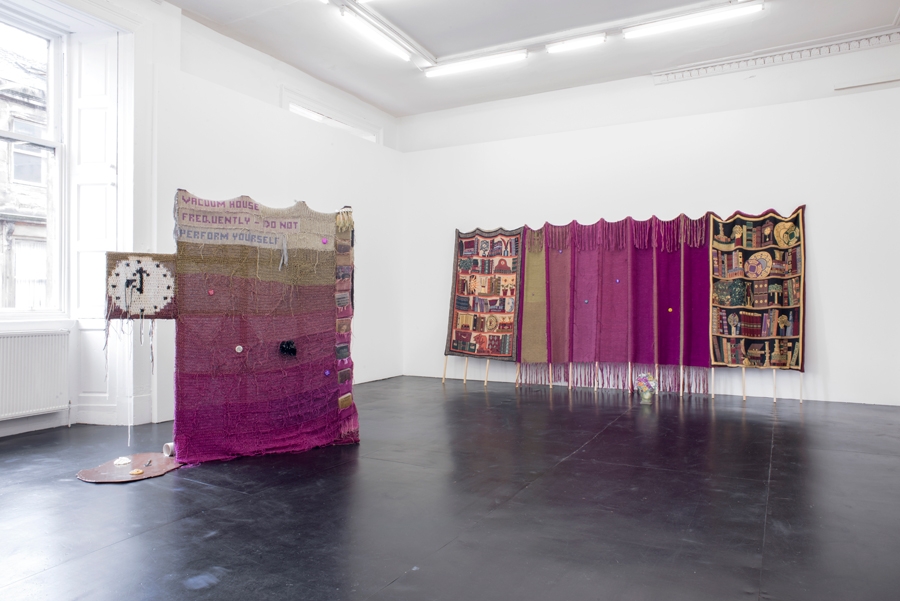On first encounter, it’s hard to know just what to make of Josh Faught’s work. I expected to hate it. I left as an enthusiastic (chastened) convert. The seven works that make up I Came into This Room for a Reason are not easy to love. They look like some kind of throwback to either postminimalist, Eva Hesse-inflected forms (avant-garde) or the type of crafting-as-catharsis hobbyist assemblage you could imagine Claire’s mother making in the early 2000s HBO series Six Feet Under (kitsch). In reality, they are both, and so much more. But let’s face it – woven and crocheted sculptures in hand-dyed hues of daffodil, baby-blue and raspberry do not, immediately, ‘look like’ cutting-edge contemporary art. The Mauve Decade (#1) (all work 2014), for example, could be a hippy’s room divider or dysfunctional hemp windbreak. But this is their real power – underestimate at your peril. Faught’s anachronistic, irreverent aesthetic acts as a critical Trojan horse for highly sophisticated, politicised works that embody serious, thoughtful concerns.
All of the works consist of handwoven, hand-dyed textiles adorned with assorted (usually found or gifted) ephemera – badges, small text-based signs, fake foods, mugs, greetings cards, sequins, books and so on. In some works, such as Bookends (Raspberry Rut) and Interiors, Faught’s own (virtuoso) weaving and crochet is linked with painstakingly sourced jacquard afghan coverlets that conform to a specific nineteenth-century American weaving technique called ‘summer and winter’. These are ostensibly ‘reversible’ blankets in which different (and therefore ‘seasonally appropriate’) colours can be woven on each side. They aren’t dissimilar to Lucy McKenzie’s trompe l’oeil-esque blankets as part of Atelier E.B. or Lucienne Day’s zodiac silk mosaics in colour scheme, style and imagery.
The titles and accompanying descriptions also provide a ‘way in’. The title of The Mauve Decade, for example, refers to the 1890s, in which the colour mauve (and lavender) was – as it continues to be – seen as a signifier for homosexuality (see the classic line in Tony Kushner’s play Angels in America, 1991, or the prominence of mauve in LGBT flags). This isn’t the first or last reference to identity politics in Faught’s work, and the history of the role of craft – textiles in particular – in and as political activism is clear both here and in previous works, eg, in his replication of sections of the AIDS Memorial Quilt. Emotional Friend is another leading title, and the work’s inclusion of actual greetings cards, badge, mug and similar items attached to the woven material highlights the artist’s interest in ‘mechanisms of survival’ – emotional and psychological props such as comfort eating, self-help or how-to manuals. These, and the homespun and workplace wisdom of the numerous badges, signs and pins bearing passive-aggressive adages and clich.s could be seen as ironic (many are very funny).
But if they are, they also manage to be humane, even poignant, in Faught’s hands. There is certainly no ridicule of people who indulge in such interests. As well as detailing absorbing personal and social histories, these items reflect another recurrent theme of the exhibition – history and the passage of time. Many pieces incorporate clocks, calendars, cards and other devices that mark or track time in some way, and the subject is explored literally through material and image – the slow, labour-intensive making of the works (handwoven, hand-dyed), forecasting (fashion, colour, astrology) and the accelerated, quick-fix forms of one-liners, aphorisms, found objects and fake snack foods such as cookies. Faught has described such snacks as representing liminal spaces, foods we eat ‘in between’ which are both comfort and vice. To Glasgow-based gallerist Kendall Koppe’s credit, I Know I Came into This Room for a Reason is the first time Faught’s work has been seen in a UK or European gallery. It should be the start of far greater interest in an artist whose work encapsulates what that overused term ‘practice’ should entail.
This article was first published in the December 2014 issue.
